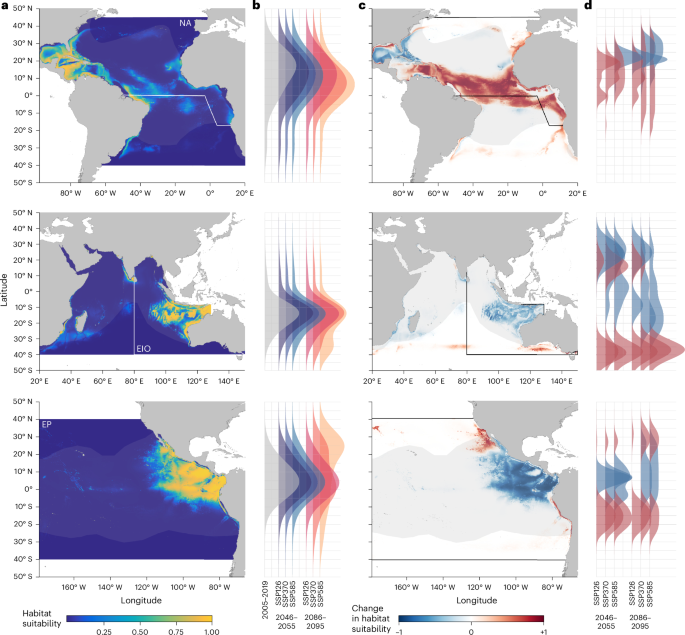Climate-driven global redistribution of an ocean giant predicts increased threat from shipping
IF 29.6
1区 地球科学
Q1 ENVIRONMENTAL SCIENCES
引用次数: 0
Abstract
Climate change is shifting animal distributions. However, the extent to which future global habitats of threatened marine megafauna will overlap existing human threats remains unresolved. Here we use global climate models and habitat suitability estimated from long-term satellite-tracking data of the world’s largest fish, the whale shark, to show that redistributions of present-day habitats are projected to increase the species’ co-occurrence with global shipping. Our model projects core habitat area losses of >50% within some national waters by 2100, with geographic shifts of over 1,000 km (∼12 km yr−1). Greater habitat suitability is predicted in current range-edge areas, increasing the co-occurrence of sharks with large ships. This future increase was ∼15,000 times greater under high emissions compared with a sustainable development scenario. Results demonstrate that climate-induced global species redistributions that increase exposure to direct sources of mortality are possible, emphasizing the need for quantitative climate-threat predictions in conservation assessments of endangered marine megafauna. The authors use long-term satellite tracking to project climate-induced shifts in whale shark distributions and understand their potential future risk of ship-strike. Under high-emission scenarios, the movement of sharks to current range-edge habitat is linked to 15,000-fold increased co-occurrence with ships.


气候驱动的全球海洋巨兽重新分布预示着航运威胁的增加
气候变化正在改变动物的分布。然而,受威胁的海洋巨型动物未来的全球栖息地将在多大程度上与现有的人类威胁重叠,这个问题仍未解决。在这里,我们利用全球气候模型和世界上最大的鱼类--鲸鲨的长期卫星跟踪数据估算出的栖息地适宜性,来说明现今栖息地的重新分布预计会增加该物种与全球航运的共同出现。我们的模型预测,到 2100 年,一些国家水域的核心栖息地面积将减少 50%,地理位置将迁移 1000 多公里(每年迁移 12 公里)。据预测,在目前的范围边缘区域,栖息地的适宜性将提高,从而增加鲨鱼与大型船只的共同出现。与可持续发展情景相比,高排放情景下的未来增幅是可持续发展情景下的 15,000 倍。研究结果表明,气候引起的全球物种重新分布有可能增加直接的死亡来源,这强调了在濒危海洋巨型动物保护评估中对气候威胁进行定量预测的必要性。
本文章由计算机程序翻译,如有差异,请以英文原文为准。
求助全文
约1分钟内获得全文
求助全文
来源期刊

Nature Climate Change
ENVIRONMENTAL SCIENCES-METEOROLOGY & ATMOSPHERIC SCIENCES
CiteScore
40.30
自引率
1.60%
发文量
267
审稿时长
4-8 weeks
期刊介绍:
Nature Climate Change is dedicated to addressing the scientific challenge of understanding Earth's changing climate and its societal implications. As a monthly journal, it publishes significant and cutting-edge research on the nature, causes, and impacts of global climate change, as well as its implications for the economy, policy, and the world at large.
The journal publishes original research spanning the natural and social sciences, synthesizing interdisciplinary research to provide a comprehensive understanding of climate change. It upholds the high standards set by all Nature-branded journals, ensuring top-tier original research through a fair and rigorous review process, broad readership access, high standards of copy editing and production, rapid publication, and independence from academic societies and other vested interests.
Nature Climate Change serves as a platform for discussion among experts, publishing opinion, analysis, and review articles. It also features Research Highlights to highlight important developments in the field and original reporting from renowned science journalists in the form of feature articles.
Topics covered in the journal include adaptation, atmospheric science, ecology, economics, energy, impacts and vulnerability, mitigation, oceanography, policy, sociology, and sustainability, among others.
 求助内容:
求助内容: 应助结果提醒方式:
应助结果提醒方式:


